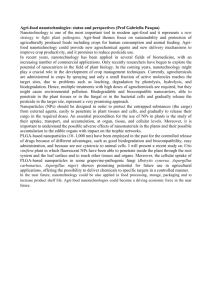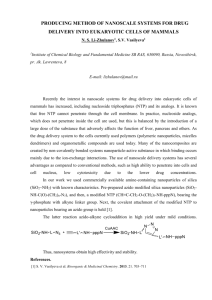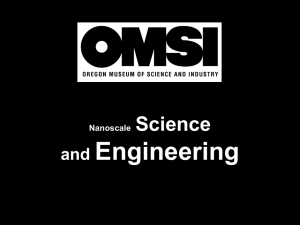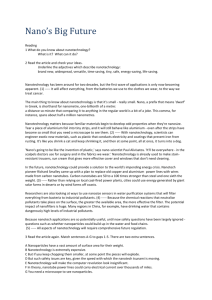Cumulative Summary
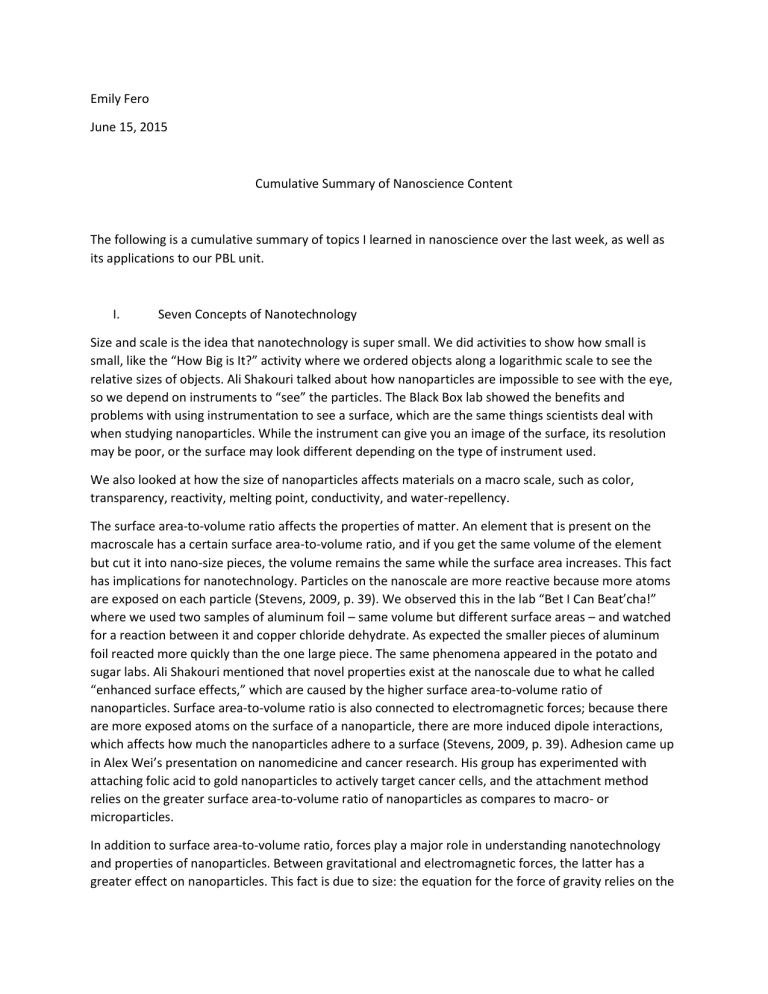
Emily Fero
June 15, 2015
Cumulative Summary of Nanoscience Content
The following is a cumulative summary of topics I learned in nanoscience over the last week, as well as its applications to our PBL unit.
I.
Seven Concepts of Nanotechnology
Size and scale is the idea that nanotechnology is super small. We did activities to show how small is small, like the “How Big is It?” activity where we ordered objects along a logarithmic scale to see the relative sizes of objects. Ali Shakouri talked about how nanoparticles are impossible to see with the eye, so we depend on instruments to “see” the particles. The Black Box lab showed the benefits and problems with using instrumentation to see a surface, which are the same things scientists deal with when studying nanoparticles. While the instrument can give you an image of the surface, its resolution may be poor, or the surface may look different depending on the type of instrument used.
We also looked at how the size of nanoparticles affects materials on a macro scale, such as color, transparency, reactivity, melting point, conductivity, and water-repellency.
The surface area-to-volume ratio affects the properties of matter. An element that is present on the macroscale has a certain surface area-to-volume ratio, and if you get the same volume of the element but cut it into nano-size pieces, the volume remains the same while the surface area increases. This fact has implications for nanotechnology. Particles on the nanoscale are more reactive because more atoms are exposed on each particle (Stevens, 2009, p. 39). We observed this in the lab “Bet I Can Beat’cha!” where we used two samples of aluminum foil – same volume but different surface areas – and watched for a reaction between it and copper chloride dehydrate. As expected the smaller pieces of aluminum foil reacted more quickly than the one large piece. The same phenomena appeared in the potato and sugar labs. Ali Shakouri mentioned that novel properties exist at the nanoscale due to what he called
“enhanced surface effects,” which are caused by the higher surface area-to-volume ratio of nanoparticles. Surface area-to-volume ratio is also connected to electromagnetic forces; because there are more exposed atoms on the surface of a nanoparticle, there are more induced dipole interactions, which affects how much the nanoparticles adhere to a surface (Stevens, 2009, p. 39). Adhesion came up in Alex Wei’s presentation on nanomedicine and cancer research. His group has experimented with attaching folic acid to gold nanoparticles to actively target cancer cells, and the attachment method relies on the greater surface area-to-volume ratio of nanoparticles as compares to macro- or microparticles.
In addition to surface area-to-volume ratio, forces play a major role in understanding nanotechnology and properties of nanoparticles. Between gravitational and electromagnetic forces, the latter has a greater effect on nanoparticles. This fact is due to size: the equation for the force of gravity relies on the
masses of two objects, which are miniscule for nanoparticles; whereas the equation for the force of electromagnetism depends on charge instead, which is present in nanoparticles. Therefore electromagnetism is more influential at the nanoscale level. We completed a few labs relating nanoscience and forces, such as the gravitational vs. electromagnetic activity and the “Does it Pour
Out?” lab. In the former, we did calculations that proved that electromagnetic force is stronger at the nanoscale than gravitational force. In the latter, we discovered that water clings more strongly to the surface of a plastic test tube that has a small diameter than one with a large diameter. In the smaller test tube, the gravitational force had less effect on the water than the electromagnetic force. The same principle holds for nanoparticles, and in fact the effect is stronger the smaller the particles get. Ali
Shakouri talked about this effect in his presentation, specifically the hydrophobic and hydrophilic interaction which occurs because of the dipoles on the atoms. Researchers use that quality to attach ligands to gold nanoparticles, which then travel more directly to the tumor because tumors are greedy for ligands at a certain stage in their growth. It is a targeting strategy that they are testing.
Since the scale of nanotechnology is so miniscule, we often use macroscale models to represent properties of nanoparticles. For example in order to understand how scientists see on such a small scale, you might use something like the Black Box activity. Using a poker, measure relative heights of an unseen surface inside a shoe box. It is difficult capturing the range of heights accurately, representing them in a 2D form on paper, and getting enough data to accurately portray the surface. Ali Shakouri explained how the atomic force microscope (AFM) “sees” on the nanoscale; the instrument uses a tip that is a group of atoms and is set on a cantilever that taps along the surface that is being studied. When the tip comes close to the surface (electromagnetic forces let the instrument know it is close without touching the surface), the AFM records the location and height. Shakouri said that depending on the instrument used, the image produced could look different. The same challenges we faced in the black box activity are the ones that scientists face when studying nanoparticles.
The size of a particle affects a range the properties of a material other than water repellency, such as color, adhesion, conductivity, water solubility, and transparency. Alex Wei mentioned that nanoparticles of gold are wine-colored and clear, which we saw in the Gold Nanoparticle lab. This is because at such a small scale, the way light interacts with the nanoparticle causes it to be red. There is more surface area on a smaller particle, so there are more exposed electrons, which means that when light hits the nanoparticle, more electrons reach the excited state than if the particles were on a macroscale. We also explored the concept of hydrophobia and hydrophilia in the labs on size-dependent properties. Water repellency, which showed up in the sand, t-shirt, and vegetable station, is not only to size, but is related to nanoscience and forces because there are nanoparticles attached to a molecule that are hydrophobic on one end.
Self-assembly is a process in which particles group together to create a uniform structure without external manipulation, and it is dependent on the environment. Ali Shakouri stated that self-assembly is a bottom-up approach to nanotechnology. There is only so much cutting and shaving one can do to a larger particle to get it to the nanoscale, so the other approach is to group atoms and molecules to form the desired nanoparticles. Self-assembly relies on electromagnetic forces, the shape of the particles, and the temperature (and therefore motion of the particles). Particles in a colder environment have a less energetic state, and so when they come in contact they stick if they have opposite charges; they are less likely to break apart because they have less energy. a
II.
Relationship of Nanotechnology to the PBL Unit and Instructional Activities
Our driving question is “How will nanotechnology influence the structure and design of a future cell phone?” We are asking students to think about functions and designs of cell phones that currently exist or that they would like to see in the future, and how they can improve them through nanotechnology.
Nanotechnology not only allows us to shrink products, but can give us the capability to change some of the properties of the materials that go into cell phones. For example, properties like color, water repellency, reactivity, and heat conduction. Students will do a few labs throughout the unit, such as an
Excel activity where they look at the relationship between the surface area-to-volume ratio and three other factors: surface area, length, and volume. In this lab, students notice that the surface area-tovolume ratio is higher for smaller solids than larger solids of the same shape. In terms of nanoscience, this means that the nanoparticles have a high surface area-to-volume ratio, which means they have more electrons on their surface, which makes them more reactive.
Students will also do a size-dependent lab in which they will choose three of four stations that demonstrate how the size of particles affect the properties of the matter. For example, students will pour water and oil on two types of sand to see that one type is hydrophilic, while other is hydrophobic due to a silicon-based coating. In another station, students pour a variety of liquids on different t-shirts – a normal one, one sprayed with stain resistant spray, and one that is strain resistant. The stain resistant t-shirt has nanoparticles of silica that repel water due to the angle and texture of the silica coating, similar to the sand station. In the sunscreen station, there are two types of sunscreen, one with nanoparticles that make the sunscreen clear, and another normal one. The nanoparticles in the sunscreen are so small that they do not reflect visible light like normal sunscreen, but they still reflect
UV light. This station shows that the size of the particles affects the color or transparency of some things. Finally, students can choose a station with liquid crystal sheets. Some of them change color immediately when contacted by heat or cold, and another changes more slowly. The difference is caused by the ratio between the two compounds that create the crystals. In the one that changes color more quickly, the structure of the crystals is such that the electrons reach an excited state more quickly.
The change in color and the speed of the change is caused by the size of the nanoparticles.
In the Pour It Out lab, students will observe how gravitational force has less of an effect on water than electromagnetic forces when dealing with a smaller scale. In addition, the lab gives students a model of how properties are different on the nanoscale, and they can see it on the macroscale. Finally, in the How
Big is It activity, students arrange cards of objects from the atomic scale to the macroscale, which should give them a sense of the size and scale of nanoparticles relative to the size of objects in their everyday life.
All of the activities mentioned are designed to help students understand nanoscience better and to give them ideas about how properties of matter change when particles are nano-sized. Seeing how matter can act differently should give students ideas about how cell phones might change in the future using nanotechnology.
III.
Addressing Misconceptions about Nanotechnology
Because nanotechnology is most likely a new topic to students and is not one they experience in their everyday lives, they will have misconceptions about what nanotechnology is and how it works. In the
How Big is It activity, students will probably have difficulty ordering objects at the two ends of the scale: atomic/nano and macro. For example, students may not know that the official start of outer space is less than the distance a car can travel on a freeway in 1 hour, or that the width of a water molecule is smaller than the diameter of a cesium atom, because they have little or no practical experience with numbers at this scale. To help students address this misconception, students can look up sizes and distances and compare them. Students may have to convert some units if they do not know which units are larger, which they can do online. The activity is meant to help students work with objects at sizes and scales they are not familiar with so they can get a better sense of the correct relative sizes.
Students may think that nanotechnology can creates phones that do anything. Most of the activities in this unit are intended to help students see which properties are changeable using nanotechnology and give them a sense of how that could affect cell phone technology. They have to be aware that the laws of physics still apply. In addition, we are having students read articles in the Jigsaw activity on current progress in nanotechnology and cell phones to give students an idea of what is possible.
In the Does it Pour Out activity, students may come up with a variety of explanations for why the water in the smaller test tube does not come out when the tube is turned upside down. They may say that it happens because it weighs less or there is some coating on the inside of the smaller test tube. Students deal with gravitational force regularly, whereas it may seem to them that electromagnetic forces have less of an impact on objects. Students need to know that electrostatic forces actually have more influence for smaller objects, such as ones on a nanoscale, than for large ones.
In the Excel activity, students are asked to relate the surface area-to-volume ratio to a number of factors. Many students think that when the size of an object increases (usually they are referring to volume), then the surface area-to-volume ratio also increases, whereas the opposite is actually true.
This is a concept that students can understand at a larger scale. For example, in the worksheet for this activity, students are asked an extension question about dogs and whether a smaller dog or a larger dog would shed more fur per pound (given than shedding rates are equal). Students can also think of food products they buy and how much packaging is used for products with different volumes. The activity also allows students to work with Playdoh, and they should notice that doubling the length of a cube causes the volume to more than double. (It actually increases by a factor of eight.) The math itself might also convince some students that the surface area-to-volume ratio does not have a linear relationship with side length, surface area, or volume.
IV.
Questions
In all that we have studied about nanoscience, I still have trouble relating the properties we talked about at the nanoscale to changes in matter at a micro- and macroscale, specifically how they could change electronics in the future. The activities we did in the lab still seem disconnected to the project I want my students to do because I do not totally understand the practical applications of what we learned in class. For example, how does electromagnetic force relate to nanotechnology in cell phones?
Alex Madsen comment: “I think it can help with a variety of things. You can use the fact that electromagnetic force plays a role in properties changing at the nanoscale to find materials that can increase battery life, allow the screen to be flexible or to produce holograms. Here is an article for another application.” http://spectrum.ieee.org/nanoclast/semiconductors/nanotechnology/tricorderlike-mobile-phonesenabled-by-nanotechnology
V.
Resources
“Does It Pour Out?” Activity. Adapted by Alex Madsen. (2015). RGS summer workshop.
Excel SA/V Activity. Adapted by Alex Madsen. (2015). RGS summer workshop.
“How Big is It?” Activity. Adapted by Alex Madsen. (2015). RGS summer workshop.
Shakouri, Ali. “Overview of Nanotechnology.” Purdue University. DLRC, West Lafayette, IN. 8 June 2015.
Presentation for Research Goes to School.
Size-Dependent Properties Activity. Adapted by Alex Madsen. (2015). RGS summer workshop.
Stevens, Shawn Y., LeeAnn M. Sutherland, and Joseph S. Krajcik. The Big Ideas of Nanoscale Science and
Engineering: A Guidebook for Secondary Teachers. NSTA Press, 2009.
Wei, Alex. “Nanomedicine: Science or Science Fiction?” Purdue University, DLRC, West Lafayette, IN. 9
June 2015. Presentation for Research Goes to School.


